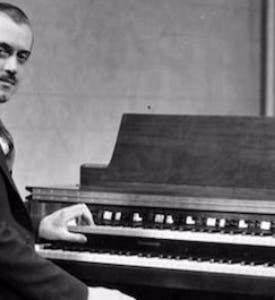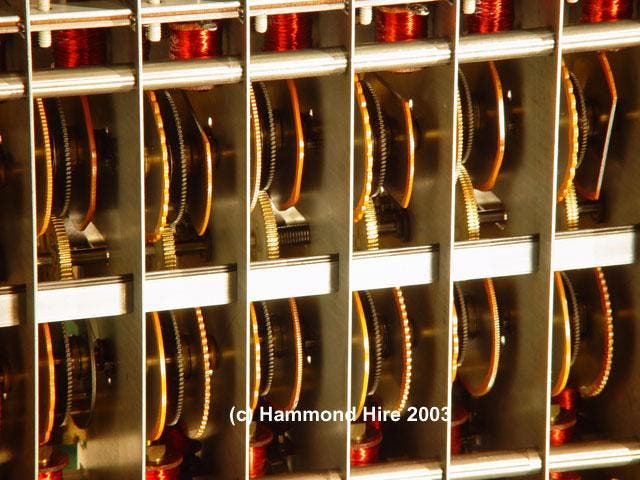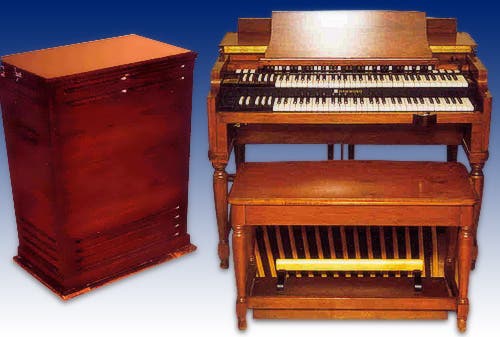Scientist of the Day - Laurens Hammond
Laurens Hammond, an American engineer and inventor, was born Jan. 11, 1895. In the 1920s, Hammond founded a company that marketed a variety of electric clocks, made possible by his invention of a small synchronous motor. When his company was struggling during the Depression, it occurred to Hammond that since his motors were so stable, he might be able use them to generate musical tones, leading to a new kind of musical instrument. And so he created (or rather adapted) the tone wheel, a little spinning disk that has indentations like a gear. When rotated near an electromagnetic pickup, it would generate a pure tone, such as 440 hertz (cycles per second), the standard tuning pitch known as concert A (second image). Since the A produced by, say, a violin, consists of the tonic note plus a number of overtones, one needs additional tone wheels that generate 880, 1320, 1760, etc. Hz to create an acceptable imitation of a violin. And then, one needs a way to pick out the overtones appropriate for that particular instrument, and combine them in the right proportions to produce the special tone of the violin. If this sounds easy, it was not; it was incredibly difficult, and yet somehow Hammond and his team managed to come up with a device that incorporated 91 tonewheels and a range of drawbars to make the right combinations, all coupled to a piano keyboard. The result was the Hammond organ, patented in 1934, with the first production models appearing in 1935. It was an instant sensation. Henry Ford brought Hammond to Dearborn for a personal demonstration and immediately ordered six for the various buildings of his outdoor museum. The Hammond organ was introduced to the public at the Industrial Arts Exposition that opened at Radio City in New York in April of 1935, and it was the hit of the show. George Gershwin wanted one (he actually received production model #1) and so did Sigmund Romberg and a host of other admirers.
Although Gershwin actually used his organ to compose, most Hammonds were bought by churches and ballparks, until the early 1950s, when they began to attract the attention of jazz pianists, especially Jimmy Smith, who showed that the Hammond was not just a cheap substitute for a pipe organ, but a bonafide performance instrument in its own right. Here is a clip of the Jimmy Smith Trio performing “The Sermon”. And then, in the mid-sixties, the Hammond organ took its next leap, as if was discovered by rock bands. The unique sound of the Hammond appealed to rock groups seeking a signature sound. The Hammond organ appeared first and most famously in Bob Dylan's "Like a Rolling Stone" (1965), followed by the Spencer Davis Group's "Gimme Some Lovin'” (1966), Procol Harum's "Whiter Shade of Pale" (1967), Deep Purple's "Hush" (1968), and a host of others.
The Hammond Company made many models of their tone-wheel organ, but the most popular for rock musicians was the B-3, which we show here (fourth image). The speaker pictured next to the organ, known as a Leslie, was especially designed for use with Hammond organs; it had a rotating tweeter at the top which produced a Doppler warble that seemed to fit quite well with the tone-wheel sound. But that is a story for Don Leslie's birthday.
The B-3 was what is called an electric or electromagnetic instrument; it had no electronics at all except in the amplifier. With the rise of the electronics industry in the seventies, the tonewheel was doomed, as it was easier and cheaper to generate sounds with synthesizers. Nevertheless, there are many that swear that the whir of the tonewheels and the leakage between pickups is essential to the sound of the Hammond B-3 and cannot be duplicated electronically. Which is why, we suppose, there are fifty-year-old Hammond B-3s and other early models available on the vintage instruments market, at very high prices, and sold not as artifacts, but as working instruments. It is a tribute to Hammond's engineering skill that so many of these instruments can still make beautiful music. Dr. William B. Ashworth, Jr., Consultant for the History of Science, Linda Hall Library and Associate Professor, Department of History, University of Missouri-Kansas City. Comments or corrections are welcome; please direct to ashworthw@umkc.edu.









